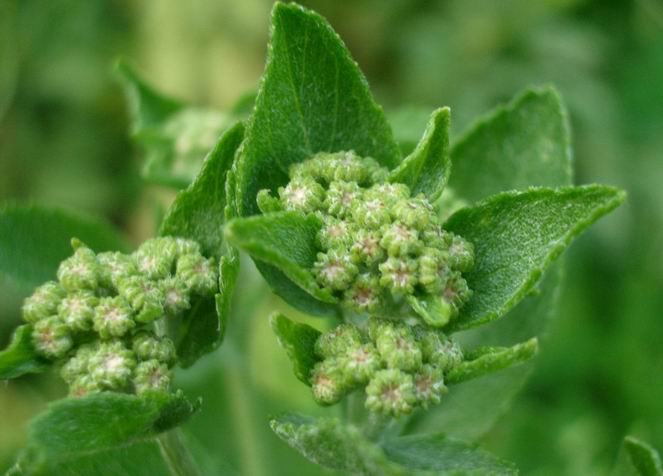Tanacetum balsamita on:
[Wikipedia]
[Google]
[Amazon]
''Tanacetum balsamita'' is a perennial temperate herb known as costmary, alecost, balsam herb, bible leaf, or mint geranium.

Description
Costmary is a perennial with oval serrated leaves and can grow up to high. During summer, it shows small, yellow, button-shaped blossoms which appear in clusters.Name
The English name 'costmary' stems from ' costus of Saint Mary'. Also, in other languages, it is associated with the Virgin Mary, most probably because it is sometimes used to treat women's diseases.Origin and spread
The plant seems to have originated in the Mediterranean. Whether the plant called "balsamita" described byColumella
Lucius Junius Moderatus Columella (; Arabic: , 4 – ) was a prominent writer on agriculture in the Roman Empire.
His ' in twelve volumes has been completely preserved and forms an important source on Roman agriculture, together with the wo ...
in 70 AD is the same is unclear. According to Heinrich Marzell, it was first mentioned in 812 in a plant catalogue. Costmary was widely grown since the medieval times in herb gardens until the late 19th and early 20th centuries for medical purposes. Nowadays, it has mostly disappeared in Europe, but is still widely used in southwest Asia.
It was used in medieval times as a place marker in Bible
The Bible (from Koine Greek , , 'the books') is a collection of religious texts or scriptures that are held to be sacred in Christianity, Judaism, Samaritanism, and many other religions. The Bible is an anthologya compilation of texts ...
s. It is referred to by Nicholas Culpeper
Nicholas Culpeper (18 October 1616 – 10 January 1654) was an English botanist, herbalist, physician and astrologer.Patrick Curry: "Culpeper, Nicholas (1616–1654)", ''Oxford Dictionary of National Biography'' (Oxford, UK: OUP, 2004) His bo ...
as the 'balsam herb'.
Chemical constituents
Leaves of the plant have been found to contain a range of essential oils. A Spanish study found the oil includescarvone
Carvone is a member of a family of chemicals called terpenoids. Carvone is found naturally in many essential oils, but is most abundant in the oils from seeds of caraway (''Carum carvi''), spearmint (''Mentha spicata''), and dill.
Uses
Both c ...
as the main component (51.5%, 41.0%, and 56.9% in three samples), together with minor amounts of β-thujone, ''t''-dihydrocarvone, ''c''-dihydrocarvone, dihydrocarveol isomer, ''c''-carveol, and ''t''-carveol. Levels of β-thujone, a toxic
Toxicity is the degree to which a chemical substance or a particular mixture of substances can damage an organism. Toxicity can refer to the effect on a whole organism, such as an animal, bacterium, or plant, as well as the effect on a subs ...
ketone, were 9.8%, 12.5%, and 12.1% in the respective samples.
Traditional medicine
In medieval times, costmary was used for menstruation problems. In the 18th century, it was classified as laxative, against stomach problems, and as an astringent. It was recommended against melancholy and hysteria, as well as dysentery and against gallbladder disease. The plant is known from ancientherbal
A herbal is a book containing the names and descriptions of plants, usually with information on their medicinal, tonic, culinary, toxic, hallucinatory, aromatic, or magical powers, and the legends associated with them.Arber, p. 14. A herbal m ...
s and was widely grown in Elizabethan knot garden
A knot garden is a garden of formal design in a square frame, consisting of a variety of aromatic plants and culinary herbs including germander, marjoram, thyme, southernwood
''Artemisia abrotanum'', the southernwood, lad's love, or southern ...
s.
The 17th-century herbalist Nicholas Culpeper
Nicholas Culpeper (18 October 1616 – 10 January 1654) was an English botanist, herbalist, physician and astrologer.Patrick Curry: "Culpeper, Nicholas (1616–1654)", ''Oxford Dictionary of National Biography'' (Oxford, UK: OUP, 2004) His bo ...
says of costmary:
"It is under the dominion of Jupiter. The ordinary costmary, as well as maudlin, provokes urine abundantly, and softens the hardness of the mother; it gently purgeth choler and phlegm, extenuating that which is gross, and cutting that which is tough and glutinous, cleanseth that which is foul, and prevents putrefaction; it openeth obstructions and relieves their bad effects, and it is beneficial in all sorts of dry agues. It is astringent to the stomach, and strengtheneth the livers other viscera: and taken in whey, worketh more effectively. Taken fasting in the morning, it relieves chronic pains in the head, and to stay, dry up, and consume all their rheums or distillations from the head into the stomach, a much to digest raw humours gathered therein, It is profitable for those hoare fallen into a continual evil disposition of the body, called cachexy, especially in beginning of the disease. It is good for weak and cold livers. The seed is given to children for worms, and so is the infusion of flowers in white wine, about two ounces at a time. It maketh an excellent salve to heal old ulcers, being boiled with oil of olive, and adder's tongue with it; and after is strained, put in a little wax, rosin, and turpentine to make it as thick as required."

References
Further reading
* Culpepers British Herbal - Pub. William Nicholson and Son - C. 1905 (re-print of the 1653 original) {{Taxonbar, from=Q1451844 balsamita Plants described in 1753 Taxa named by Carl Linnaeus